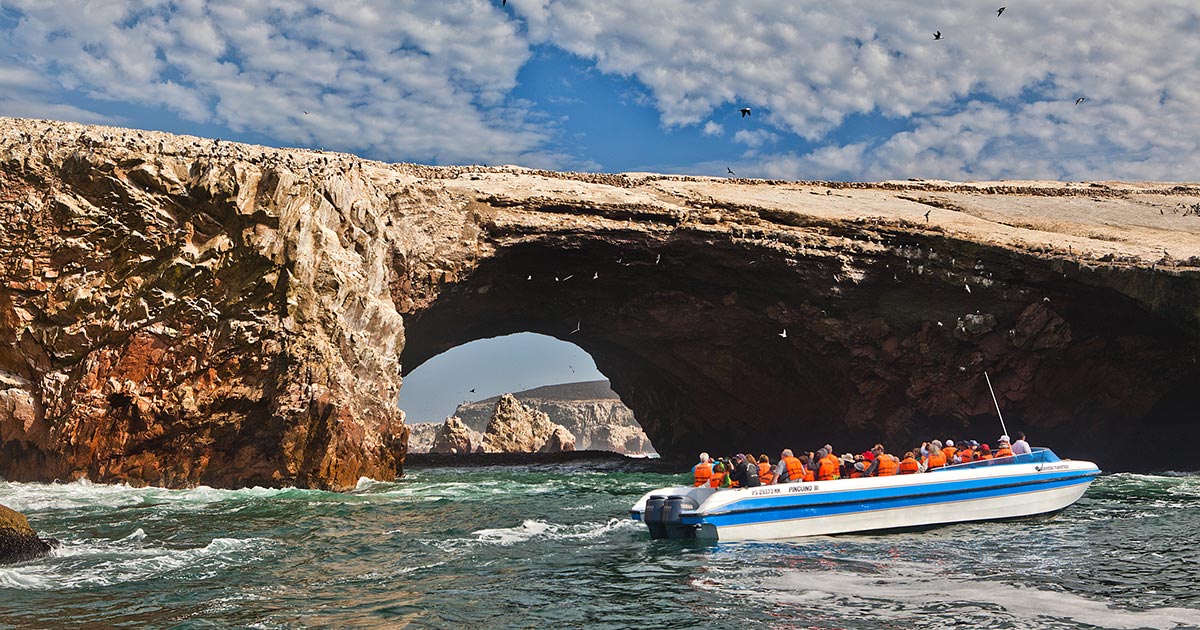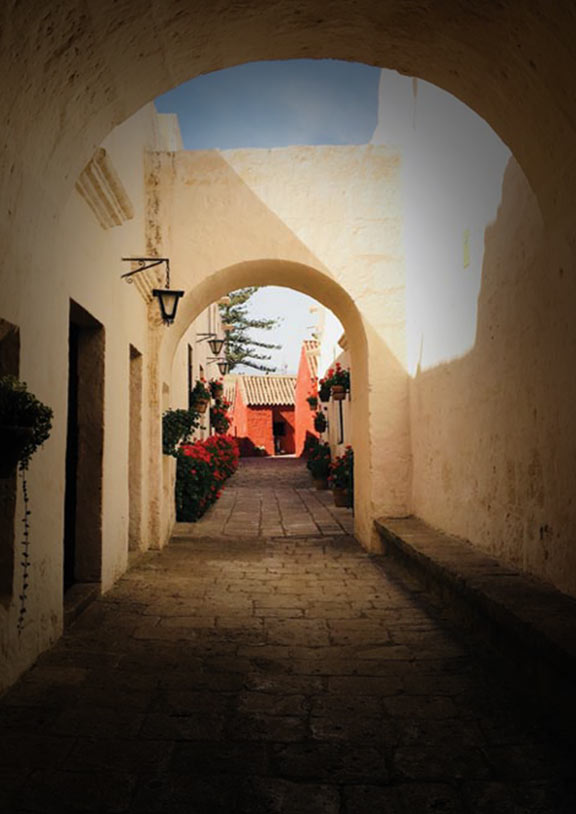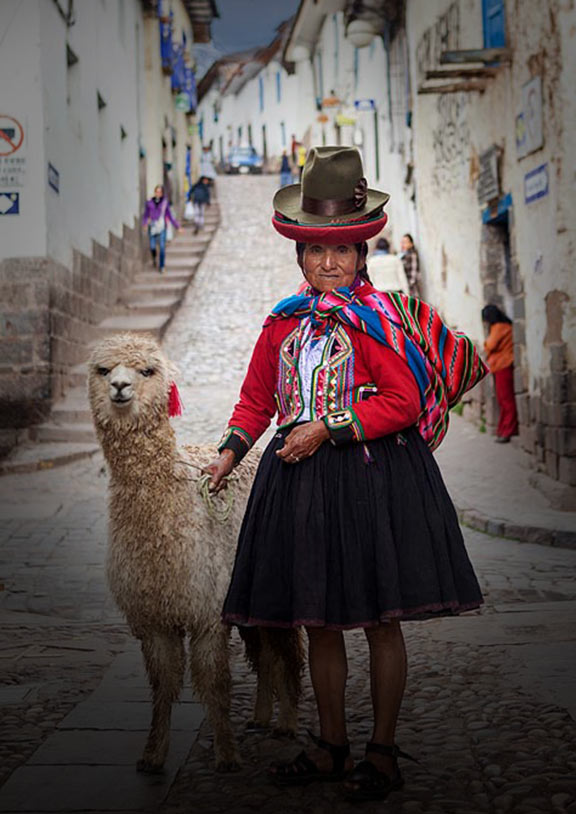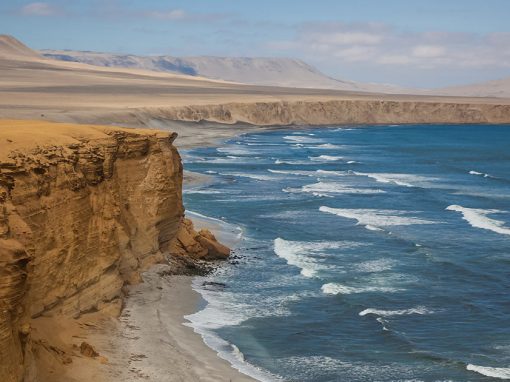The desolate desert coast of Peru may seem void of large wildlife until you take to the sea. Coastal reserves and tiny islands support remarkable marine diversity. Everything from sea lions to penguins come to a pinnacle on the Ballestas Islands, offering one of the best wildlife-spotting experiences in the country. The collection of rocky islands is a short boat ride from Paracas (an area also known for the famous Paracas National Reserve) and home to marine creatures such as Humboldt penguins, Guanay cormorants, and sea lions.
Overview
Wildlife
History
Traveler Info
Tour Planning
Overview
The Ballestas Islands (officially called Islas Ballestas) is the leading attraction that draws the majority of visitors to Paracas. Ideal conditions created by the Humboldt Current enable the animal inhabitants of the Ballestas and the nearby Paracas Peninsula to thrive. The cold current pulls up water from the ocean floor, bringing both lower temperatures and nutrients to the surface. These conditions create an ideal feeding zone for fish, consequently drawing larger predators.

One of the largest colonies of sea lions in South America lives in the Ballestas Islands as well as diverse seabirds. Photo by Peru For Less.
National Reserve
The Ballestas Islands are not within the Paracas National Reserve. Instead, they belong to the Guano Islands, Islets, and Capes National Reserve System or La Reserva Nacional Sistema de Islas, Islotes, y Puntas Guaneras. This expansive Peruvian reserve includes the guano islands like the Ballestas and their ecosystems all along the coast from Tacna to Piura. Special legislation within the reserve permits guano mining with restrictions.
Three main islands form the isles: Ballesta Norte, Ballesta Central, and Ballesta Sur. Environmental laws prevent visitors from landing on the islands, so boat tours cruise their perimeters, arches, and caves for up-close wildlife observation. Shore access in the Ballestas Islands is reserved mainly for scientists and researchers.
Ballestas Islands Wildlife
Roaring sea lions and squawking birds join the crashing waves in a noisy symphony, while the sheer number of creatures make you rub your eyes in wonder. With some luck, you may spot pods of dolphins or migrating whales.
Colonies of Sea Lions and Seals
Basking in the sunlight, swimming for fish, and occasionally performing for tour boats, chocolate-colored South American sea lions are among the most charismatic residents of the Ballestas Islands. Males are huge, with giant, maned heads reminiscent of lions, and can weigh up to 770 pounds (350 kg). Females are about half the size and weight.
Also inhabiting the islands are South American fur seals. Gray or tan and smaller than sea lions, fur seals prefer to lounge on rocky shores where cliffs provide shaded areas. Females are much smaller and typically weigh between 65 and 130 pounds (30 and 60 kg). Male South American fur seals weigh up to 440 pounds (200 kg).

Seal lions and seals sharing space in the Ballestas Islands. Photo: Ballestas Islands – Paracas, Peru by Kevin Sato, used under CC BY 2.0 / Cropped and compressed from original. Viewers can download.
Calving and breeding season in Paracas is from January to March for sea lions and from October to December for fur seals. During these months, cute pups abound, and territorial adult males belch out roars to protect their harems and fend off potential rivals.
Seabirds Galore
The sheer number of bird species found nesting on steep rock surfaces and flying between islands makes the Ballestas a top spot for birding in Peru. Highlighted below are captivating birds you can observe during a tour.
Guanays are easy to distinguish from other cormorants because they have red circles around their eyes and white bellies. Guanay cormorants were the largest producer of guano, valuable bird manure used as a fertilizer, which during the 19th century was the primary national income for Peru. Learn about the fascinating guano trade and how it impacted Peruvian islands like the Ballestas in the History section below.
Humboldt penguins only populate the coast of Peru and northern Chile. Living up to twenty years, these penguins eat anchovies, herring, and other fish.

Social Humboldt penguins on the rocky banks of the Ballestas. Photo: Ballestas Islands – Paracas, Peru by Kevin Sato, used under CC BY 2.0 / Cropped and compressed from the original. Viewers can download.
Inca terns have a dark gray body with a distinct white mustache on either side of their orange-red beak.
Kelp gulls, also known as Dominican gulls, are the largest seagulls in the Ballestas Islands. Their bills are yellow with a red dot underneath, a marking different from other species of gulls in the islands.
Peruvian boobies are year-round residents of the Ballestas Islands and close cousins with blue-footed boobies that inhabit the Galapagos Islands.
Peruvian pelicans can be found up and down the coast of Peru and live in the Ballestas Islands. The throat pouch is blue, unlike that of the brown pelican whose throat pouch is olive-green to red in the breeding season.

Peruvian pelicans taking it easy in the Ballestas Islands. Photo: Islas Ballistas by David Almeida, used under CC BY 2.0 / Cropped and compressed from the original. Viewers can download.
History of Ballestas Islands
Guano Mining
Since time immemorial, seabirds have deposited their guano on the Ballestas Islands and other isles of Peru. And since the time of the Incas, this guano has been used as a fertilizer. From the mid-1800s to the early 1900s, guano became a valuable global commodity and mined extensively on Peruvian islands. Peru stuffed its coffers, but the delicate ecosystem that sustained the seabird population suffered significant damage.
Protecting Guano Islands
In 1909, the Guano Administration Company (Compañía Administradora del Guano) was created to restore the guano bird population, protect the natural environment, and manage extraction. By the mid-1900s, the wide availability of synthetic fertilizers diminished the importance of guano.
Guano, some say, used to cover the isles in layers of 65 to 230 feet (20 to 70 m) deep. Today, the guano is much thinner. Mining is limited to three months as part of protective measures enacted to avoid further disruption of the seabird ecosystem.

Birds rule the Ballestas. Photo by Peru For Less.
In 1975, the Paracas National Reserve was established to protect the marine ecosystem and remains of indigenous Paracas Culture on the mainland of the Paracas Peninsula. Later, in 2009, the Reserva Nacional Sistema de Islas, Islotes y Puntas Guaneras was created to protect the Ballestas Islands and other Peruvian isles guarding representative samples of rich and diverse Humboldt current ecosystems.
Today, more than 150,000 people per year (MINCETUR, 2018) visit the Ballestas Islands, making it a top attraction of the southern coast of Peru. In the summer months, weekend vacationers from Lima appreciate the sunshine and seafood specialties.
Traveler Info
Best Time to Visit
Paracas is a popular getaway for travelers as well as city residents of Lima. Mild annual temperatures (60-80°F | 18-27°C) and minimal rainfall make Paracas and the Ballestas Islands year-round destinations. Also, different seasons bring various wildlife highlights to the islands. The peak season for the region is during summer (December through February), Easter Week (or Semana Santa), and dates around Peru’s Independence Day (or Fiestas Patrias) every 28th and 29th of July.

Sea lions lounging around the Peruvian isles. Photo by Peru For Less.
In and Around Paracas
El Chaco, otherwise known as the “town of Paracas,” rests on the southern shores of the bay and is the departure point for Ballestas boat tours and land excursions on the Paracas Peninsula. El Chaco is only 10 miles (16 km) south of the town of Pisco and its small airport.
How to Get to the Ballestas Islands
Boat tours begin and end in El Chaco. Paracas is about 155 miles (250 km) south of Lima along the Panamerican Highway. Daily bus service connects the capital and Paracas along a direct route that takes around four hours. In some cases, buses go as far as Pisco from where you can catch a safe taxi, Uber, or local bus for the short transfer to El Chaco.
Ballestas Islands Entry Fee
Entry to the national reserve that protects the Ballestas Islands is 11 soles per adult. Sometimes the fee is included in the cost of your guided tour.
Where to Stay
The small fishing village turned tourism hub of El Chaco is a comfortable spot to base your exploration for a few nights. Restaurants and local shops are within short walking distance, and our travel experts can arrange convenient hotel pick-up for your daily guided tours. For an extra treat, enjoy one of the classy bayfront hotels in Paracas.

Enjoy an epic sunset in Paracas. Photo: Paracas Sunset by David Almeida, used under CC BY 2.0 / Cropped and compressed from the original. Viewers can download.
Motion Sickness
Travelers prone to seasickness will benefit from taking a remedy to prevent seasickness or reduce symptoms. There is no way to avoid at least a little rocking motion during a Ballestas boat tour, even during the morning when the ocean is usually calmer.
What to Pack
Travel comfortably to the Ballestas Islands with the following items:
- Sunscreen
- Windbreaker or light jacket to protect against chilly winds
- Poncho or hat to keep off potential bird droppings
- Camera with zoom
- Binoculars
- Seasickness remedy
- Life vests provided by the boat tour provider
Ballestas Islands Tours
Boat tours to the Ballestas Islands depart from El Chaco and last around two hours. Bilingual guides tell you about the animal species, as well as the mysterious shape etched into the side of a cliff along the coast, known as the Candelabro, that you pass during the outbound journey.

Pass this iconic glyph on the Paracas Peninsula on the ride to the Ballestas Islands. Photo by Peru For Less.
Buy a ticket for a tour in El Chaco or contact our travel experts to organize a fun Ballestas tour as part of your custom trip to Peru.
Group Vs. Private Boat Tour
Group tours to the Ballestas depart from the main pier in El Chaco. Daily tours start at 8 am, and the last departure is generally at 10 am or 10:30 am. Later in the afternoon, the ocean is usually too rough, so there are no tours. Occupancy varies though speedboat tours tend to be more crowded during peak southern hemisphere summer months from December to mid-March.
Private Ballestas boat tours are recommended for a more intimate experience or if you are planning a one-day getaway from Lima. Although more pricey, booking a private tour offers more flexible departure times around your itinerary and additional one-on-one time with your guide to answer all your wildlife inquiries.
Ballestas Islands Tour Combos
If you are visiting the Ballestas Islands, then you’re already heading to Paracas and have the opportunity to maximize your discovery of the country’s desert coast. Base yourself at a Paracas hotel and plan excursions to view the mysterious ancient glyphs in a plane, go sandboarding around an oasis, or sample Peruvian pisco and wine in the countryside.
Ballestas Island and Paracas National Reserve Tour
Snap photos galore during a morning tour through the Ballestas and then turn to an on-land adventure to the neighboring national reserve encompassing the Paracas Peninsula. Miles of stunning coastline and the ancient burial grounds of the Paracas culture are all part of the full Paracas experience.

Zip through the Paracas National Reserve on a quad tour. Photo by Peru For Less.
Ballestas Islands Tour from Lima
Plan a day trip from Lima to the Ballestas Islands and close-by attractions. This whirlwind itinerary involves a lot of drive time (around 6 hours roundtrip from Lima), but it’s a great way to check out the country’s southern coast highlights if your time is limited. Ask our team for more details about the best transport and Paracas tour planning for your custom-made vacation.
Ballestas Islands and Nazca Lines Tours
Discover the Ballestas Islands and take to the sky on a flyover tour of the Nazca Lines. There is a small airport in the town of Pisco, just north of El Chaco, which is where flights over the mysterious glyphs takeoff and save you the 3.5-hour drive to Nazca where tours also depart.
A common way to combine these tours together is to arrive in Pisco, embark on a Nazca Lines flight, and then check-in to a hotel in Paracas for the night. After your Nazca Lines tour, visit the Ballestas and enjoy the Paracas region before traveling onward by bus to your next destination in Peru.

The Hummingbird is one of the Nazca Lines seen on a flyover tour. Photo by Adriana P.
Ballestas Islands and Pisco Tour
Pair a wine tour in the Ica Valley with the Ballestas. About 1.5 hours from El Chaco, just outside the town of Ica, local vineyards called bodegas are the perfect place to spend a relaxing afternoon. Swirl, smell and sip a variety of wines as well as Peru’s famed clear brandy with a potent taste, pisco.
Ballestas Islands and Huacachina Oasis
Tucked away in the dunes is the oasis of Huacachina, the hub for the best sandboarding in Peru. Match your wildlife tour of the Ballestas with an adrenaline-pumping dune buggy ride and sandboarding tour.
Discover Peru is one of our exciting, customizable travel packages that features a visit to Paracas and the Ballestas Islands. Get in touch and start planning your trip to Peru.
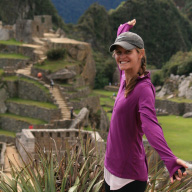
Britt is a California native who now calls Peru home. She is a traveler with a passion for all things outdoors, scuba diving, and capturing memories with her camera.


